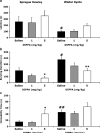Comparison of the kappa-opioid receptor antagonist DIPPA in tests of anxiety-like behavior between Wistar Kyoto and Sprague Dawley rats
- PMID: 20369354
- PMCID: PMC3370387
- DOI: 10.1007/s00213-010-1832-9
Comparison of the kappa-opioid receptor antagonist DIPPA in tests of anxiety-like behavior between Wistar Kyoto and Sprague Dawley rats
Abstract
Rationale: Recent evidence suggests a role for the dynorphin/kappa-opioid receptor (KOR) system in the expression of stress-induced behaviors. Wistar Kyoto (WKY) rats exhibit increased depression-like and anxiety-like responses in behavioral tests compared to other strains and may be a model of comorbid depression and anxiety characterized by increased activity within the dynorphin/KOR system. Though KOR antagonists produce antidepressant-like effects in WKY rats, their effects in tests of anxiety-like behavior have not been examined in the WKY strain.
Objective: The aim of the current study was to investigate the effects of the KOR antagonist 2-(3,4-dichlorophenyl)-N-methyl-N-[(1S)-1-(3-isothiocyanatophenyl)-2-(1-pyrrolidinyl)ethyl]acetamide hydrochloride (DIPPA) on the behavior of WKY rats and Sprague Dawley (SD) rats in tests of anxiety-like behavior.
Methods: The novelty-induced hypophagia and defensive burying tests were used to measure anxiety-like behavior in WKY and SD rats and determine the effects of DIPPA on anxiety-like behavior in both strains.
Results: WKY rats displayed greater amounts of anxiety-like behavior compared to SD rats. DIPPA produced anxiolytic-like effects in both tests in both strains.
Conclusions: WKY rats display more anxiety-like behavior at baseline compared to SD rats, and DIPPA produced anxiolytic-like effects in both WKY and SD rats. These findings support previous research suggesting that KOR antagonists possess anxiolytic-like properties and may potentially represent a novel class of treatments for mood disorders.
Figures


References
-
- Ahmadiyeh N, Churchill GA, Shimomura K, Solberg LC, Takahashi JS, Redei EE. X-linked and lineage-dependent inheritance of coping responses to stress. Mamm Genome. 2003;14:748–757. - PubMed
-
- Armario A, Gavalda A, Marti J. Comparison of the behavioural and endocrine response to forced swimming stress in five inbred strains of rats. Psychoneuroendocrinology. 1995;20:879–890. - PubMed
-
- Bechtholt AJ, Valentino RJ, Lucki I. Overlapping and distinct brain regions associated with the anxiolytic effects of chlordiazepoxide and chronic fluoxetine. Neuropsychopharmacology. 2008;33:2117–2130. - PubMed
-
- Bodnoff SR, Suranyi-Cadotte B, Aitken DH, Quirion R, Meaney MJ. The effects of chronic antidepressant treatment in an animal model of anxiety. Psychopharmacology (Berl) 1988;95:298–302. - PubMed
-
- Borsini F, Podhorna J, Marazziti D. Do animal models of anxiety predict anxiolytic-like effects of antidepressants? Psychopharmacology (Berl) 2002;163:121–141. - PubMed
Publication types
MeSH terms
Substances
Grants and funding
LinkOut - more resources
Full Text Sources
Medical

